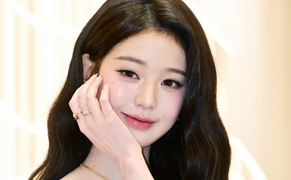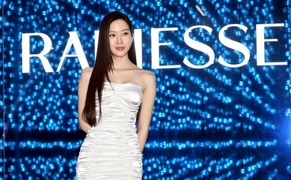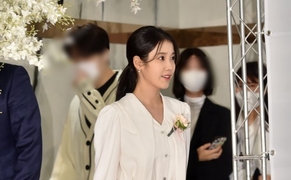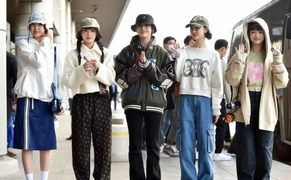2 years of honest efforts comes to fruition. Soprano Chie Sadayama's creation of a delicate and elegant Tosca
 |
| A scene from 'TOSCA' by Fujiwara Opera Company/ Provided by Fujiwara Opera Company |
Fujiwara Opera Company is the first Japanese professional opera company, established by famous tenor Yoshie Fujiwara in the year 1934. The opera company visited Chosun in 1940 to perform the opera ‘Carmen’ at Bumin’gwan, with Harbin Orchestra. That performance is recorded as the first case of the full performance of opera. Almost 90 years old, this opera company is still considered as the representative among the private opera companies. Carrying on every year with performances, it plays leading role in the Japanese opera scene.
I have watched ‘Tosca’, performed by Fujiwara Opera Company at Tokyo Ueno Bunka Kaikan. The goal was to observe the change that the opera of Japan and Tokyo is going through during the time of the pandemic, but there was one more notable factor to it. The titular role of Tosca was performed by Chie Sadayama, (Korean name Chonhye Lee), who is a third-generation Zainichi.
Soprano Chie Sadayama was born in Tottori Prefacture, and graduated in Italy’s Conservatorio di Milano. Then, she was active in both Japan and England, and she had a solo vocal recital at Korea. Nowadays, she is starring in Japan’s various operas such as ‘La Boheme’ and ‘La Traviata’. She joined Fujiwara Opera Company in 2012, and ‘Tosca’ would be her first leading role in the Company. She got the role through an audition in November of 2021, and she had been preparing for the performance for almost a year and four months.
Chie Sadayama was cast as the lead for the performance on January 29th, while the opera was performed in 28th and 29th of January. A commentator came out to give a commentary while the audience was entering the seats. I entered mid-comments, and I could listen to the detailed commentaries such as background knowledge of the opera, point of appreciation, directing intentions, and introduction of the singers, so that it could be a lot of help for the audience.
The stage that Shigetaka Matsumoto directed is very classically oriented. The acting, stage setting, costumes and lighting all were compliant to the original conception of the opera ‘Tosca’. While being a Regie-Theater, ‘Tosca’ is one of the operas that has less variations. Considering that the opera nowadays tend to become director-oriented, this constancy of ‘Tosca’ is something special. This is probably due to the strongly melodramatic nature of opera ‘Tosca’, and apparent individuality of the three main characters.
Fujiwara Opera’s production of ‘Tosca’ was a case where such characteristics shone. From the first act to the last third act, it comprised mis-en-scene of ‘Tosca’ itself, and each element was faithful to the original work. It was the music that made otherwise flat production into a three-dimensional one.
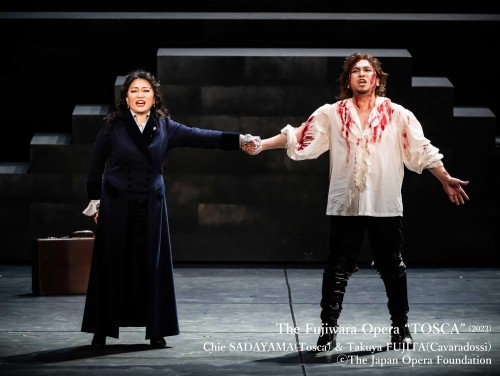 |
| A scene from 'TOSCA' by Fujiwara Opera Company/ Provided by Fujiwara Opera Company |
Chie Sadayama is a lyric soprano, whose voice is brightly melodic rather than strong or sharp. Thus she had created a character, highlighting Tosca’s fragile side, resulting in a creation of delicate and elegant figure. She also showed her mastery of singing in control of strength and tempo, despite the pressure of debuting as the lead role in Fujiwara Opera Company. The aria from the second act, ‘Vissi d'arte, vissi d'amore’, and the final duet from the end of the third act, the death of her lover, were especially powerful, impressing and captivating the audience.
The tenor who played Cavaradossi, Takuya Fujita, also showed enthusiastic acting and singing, hand in hand with Sadayama. After performing the intro of the first act, ‘Recondita armonia’ smoothly, he seemed to outpour the emotions too much in the second act. However, in the third act, through singing ‘E lucevan le stelle’, he expressed love and parting with Tosca with such desperation that the audience was totally immersed. A bariton Shingo Sudo, who played Scarpia, performed the role of evil chief of police adequately, amplifying the conflict.
Tokyo Philharmonic Orchestra, led by Erina Suzuki, supported the melody of ‘Tosca’ well, switching between the sentiment of passion and lyricism. The cello which entered during the earlier part of the third act cleans up the shock of the second act, which concluded with Tosca’s murder of Scarpia, led the audience to the quiet and desolate atmosphere where the morning star sparkled. That was the part in this opera where the delicate zest of music and direction were highlighted.
This year’s performance was as well-prepared as the previous years, but what stood out was that during the first act’s ‘Te Deum’, the choir comprising of the clergy, the chorus, and the congregation were all wearing masks. Japan, like us, is not free from COVID-19. Nonetheless, Japanese opera of the day, unlike our own opera, was full of vitality and will to overcome the pandemic. The opera was planned two years ago, where the virus was still rampant. Fujiwara Opera Company still prepared for the opera to be performed in the year 2023, and the effort was rewarded by the audience’s rounds of applause.
Sooyeoun Sohn (Opera critic/ Professor at Dankook University)
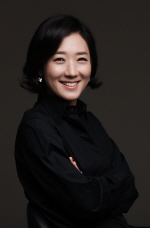 |
Translation: Yoo Min-hyung
#Tosca #Tokyo #Fujiwara Opera Company
Copyright by Asiatoday
Most Read
-
1
-
2
-
3
-
4
-
5
-
6
-
7

















